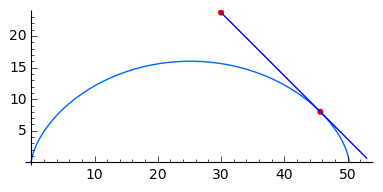Derivative of Parametric Equations
We work with parametric equations enough that it may be helpful to be able to find the derivative of a set of parametric equations at some particular point. In particular, there is often interest in finding the equation of a tangent line to a parametric curve. We should already know that the slope of a tangent line at a point on a function is the derivative of the function at that point. So the equation in point slope form of every tangent line is given by equation $\eqref{EQ 1}$. $$y-y_{1}=m(x-x_{1})$$ $$y-y_{1}=\frac{dy}{dx}(x-x_{1}) \tag{EQ 1} \label{EQ 1}$$ Clearly, if we only have the parametric equations, we will need to find $dy/dx$ from those equations. As it turns out, the derivative of parametric equations is their individual derivatives with respect to the parameter divided by each other. $$\frac{dy}{dx}=\frac{\frac{dy}{dt}}{\frac{dx}{dt}} \tag{EQ 2} \label{EQ 2}$$
Answer: This line is easy to visualize. It is vertical and intersects the unit circle at $(1,0)$. Here is the parametric unit circle equation: $$\left(\begin{array}{c} x\\ y \end{array}\right)=\left(\begin{array}{c} cos(t)\\ sin(t) \end{array}\right)$$ We first need to know what the value of $t$ will be when $1=\cos(t)$ and $0=\sin(t)$. From $1=\cos(t)$, we use the inverted function and $\arccos(1)=t=0$. Similarly for the sine, $\arcsin(0)=t=0$ . In both cases, $t=0$. Next, we carefully construct the derivative, $\frac{dy/dt}{dx/dt}$ according to $\eqref{EQ 2}$. $$\frac{dy/dt}{dx/dt}=\frac{d(sin(t))/dt}{d(cos(t)/dt}=\frac{cos(t)}{-sin(t)}=\frac{cos(0)}{-sin(0)}=\frac{1}{0}$$ Since division by zero is not OK, we have learned that the derivative at the point of interest does not exist. In this case, that is a strong clue that the line is vertical. In the point slope format, that will mean that $x=constant$, since the derivative of a constant is zero. Since we know that in at least one case, $(1,0)$, that $x=1$ then we can take that as the equation of the line.
Let's do an example that actually results in an equation.
Find the tangent to the curve given by the parametric equations $\color{red}{x(t)=r(t-sin(t))}$ and $\color{red}{y(t)=r(1-cos(t))}$, at the point where $t=3\pi/2$. See Fig. Answer: In order to use the point slope format, we will need to know values for $ x(3\pi/2)$ and $y(3\pi/2)$ {Aside: So that you don't have to look them up: $\sin(3\pi/2)=-1\qquad cos(3\pi/2)=0.$} $$x_{1}=r\left(\frac{3\pi}{2}\right)-r\cdot\sin\left(\frac{3\pi}{2}\right)=r\left(\frac{3}{2}\pi+1\right)$$ $$y_{1}=r\left(1-cos(\frac{3\pi}{2})\right)=r$$ So in point slope form, the equation is $$y-y_1=slope\cdot(x-x_1) $$ $$y-r=\frac{dy}{dx}\left(x-r\left(\frac{3}{2}\pi+1\right)\right) \tag{EQ 3} \label{EQ 3}$$ and now we need to know $dy/dx$. ($y$ and $x$ are the equations in red at the beginning of this example.) $$\frac{dy}{dx}=\frac{dy/dt}{dx/dt}=\frac{d(r-rcos(t))/dt}{d\left(rt-rsin(t)\right)/dt}=\frac{r\cdot sin(t)}{-r\left(cos(t)-1\right)}$$ $$\frac{dy}{dx}=\frac{r\cdot sin(\frac{3\pi}{2})}{-r\left(1-cos(\frac{3\pi}{2})\right)}=\frac{r}{-r(1-0)}=-1$$ Now finishing the point slope format by substituting values for $dy/dx=-1, x_{1}=r\left(\frac{3}{2}\pi+1\right)$ and $y_{1}=r$ into equation $\eqref{EQ 3}$ and simplifying. This gives the equation of the tangent line at $$t=3\pi/2.y=-x+\frac{r}{2}\left(3\pi+4\right)$$
